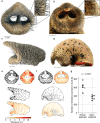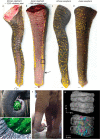The functional anatomy of elephant trunk whiskers
- PMID: 37291455
- PMCID: PMC10250425
- DOI: 10.1038/s42003-023-04945-5
The functional anatomy of elephant trunk whiskers
Abstract
Behavior and innervation suggest a high tactile sensitivity of elephant trunks. To clarify the tactile trunk periphery we studied whiskers with the following findings. Whisker density is high at the trunk tip and African savanna elephants have more trunk tip whiskers than Asian elephants. Adult elephants show striking lateralized whisker abrasion caused by lateralized trunk behavior. Elephant whiskers are thick and show little tapering. Whisker follicles are large, lack a ring sinus and their organization varies across the trunk. Follicles are innervated by ~90 axons from multiple nerves. Because elephants don't whisk, trunk movements determine whisker contacts. Whisker-arrays on the ventral trunk-ridge contact objects balanced on the ventral trunk. Trunk whiskers differ from the mobile, thin and tapered facial whiskers that sample peri-rostrum space symmetrically in many mammals. We suggest their distinctive features-being thick, non-tapered, lateralized and arranged in specific high-density arrays-evolved along with the manipulative capacities of the trunk.
© 2023. The Author(s).
Conflict of interest statement
The authors declare no competing interests.
Figures







References
-
- Dehnhardt G, Friese C, Sachser N. Sensitivity of the trunk of Asian elephants for texture differences of actively touched objects. Z. Saugetierkd. 1997;62:37–39.
-
- Boas, J. E. V., & Paulli, S. The Elephant’s Head: Studies in the Comparative Anatomy of the Organs of the Head of the Indian Elephant and Other Mammals. The Facial Muscles and the Proboscis. 1st Part. (G. Fischer, 1908).
-
- Fischer MS, Trautmann U. Fetuses of African elephants (Loxodonta africana) in photographs. Elephant. 1987;2:6. doi: 10.22237/elephant/1521732098. - DOI
-
- Cuvier, G., and Dumeril, A. M. Lecons D’anatomie Comparée: 2. Societe Typographique Belge (Crochard, 1838).
Publication types
MeSH terms
LinkOut - more resources
Full Text Sources

